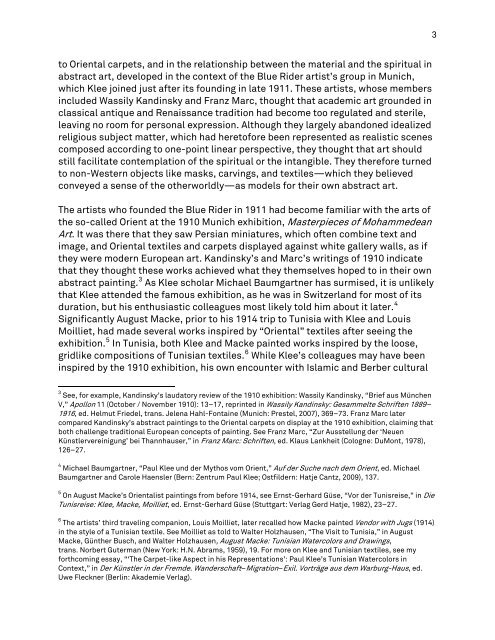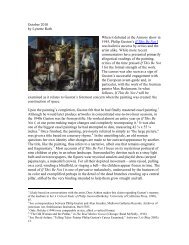Paul Klee, Zeichensammlung Südlich (Collection of Southern Signs ...
Paul Klee, Zeichensammlung Südlich (Collection of Southern Signs ...
Paul Klee, Zeichensammlung Südlich (Collection of Southern Signs ...
You also want an ePaper? Increase the reach of your titles
YUMPU automatically turns print PDFs into web optimized ePapers that Google loves.
to Oriental carpets, and in the relationship between the material and the spiritual<br />
in<br />
abstract art, developed in the context <strong>of</strong> the Blue Rider artist’s group in Munich,<br />
which <strong>Klee</strong> joined just after its founding in late 1911. These artists, whose members<br />
included Wassily Kandinsky and Franz Marc, thought that academic art grounded in<br />
classical antique and Renaissance tradition had become too regulated and sterile,<br />
leaving no room for personal expression. Although they largely abandoned idealized<br />
religious subject matter, which had heret<strong>of</strong>ore been represented as realistic scenes<br />
composed according to one-point linear perspective, they thought that art should<br />
still facilitate contemplation <strong>of</strong> the spiritual or the intangible. They therefore turned<br />
to non-Western objects like masks, carvings, and textiles—which they believed<br />
conveyed<br />
a sense <strong>of</strong> the otherworldly—as models for their own abstract art.<br />
The artists who founded the Blue Rider in 1911 had become familiar with the arts <strong>of</strong><br />
the so-called Orient at the 1910 Munich exhibition, Masterpieces <strong>of</strong> Mohammedean<br />
Art. It was there that they saw Persian miniatures, which <strong>of</strong>ten combine text and<br />
image, and Oriental textiles and carpets displayed against white gallery walls, as if<br />
they were modern European art. Kandinsky’s and Marc’s writings <strong>of</strong> 1910 indicate<br />
that they thought these works achieved what they themselves hoped to in their own<br />
abstract painting. ly<br />
f its<br />
ural<br />
3 As <strong>Klee</strong> scholar Michael Baumgartner has surmised, it is unlike<br />
that <strong>Klee</strong> attended the famous exhibition, as he was in Switzerland for most o<br />
duration, but his enthusiastic colleagues most likely told him about it later. 4<br />
Significantly August Macke, prior to his 1914 trip to Tunisia with <strong>Klee</strong> and Louis<br />
Moilliet, had made several works inspired by “Oriental” textiles after seeing the<br />
exhibition. 5 In Tunisia, both <strong>Klee</strong> and Macke painted works inspired by the loose,<br />
gridlike compositions <strong>of</strong> Tunisian textiles. 6 While <strong>Klee</strong>’s colleagues may have been<br />
inspired by the 1910 exhibition, his own encounter with Islamic and Berber cult<br />
3 See, for example, Kandinsky’s laudatory review <strong>of</strong> the 1910 exhibition: Wassily Kandinsky, “Brief aus München<br />
V,” Apollon 11 (October / November 1910): 13–17, reprinted in Wassily Kandinsky: Gesammelte Schriften 1889–<br />
1916, ed. Helmut Friedel, trans. Jelena Hahl-Fontaine (Munich: Prestel, 2007), 369–73. Franz Marc later<br />
compared Kandinsky’s abstract paintings to the Oriental carpets on display at the 1910 exhibition, claiming that<br />
both challenge traditional European concepts <strong>of</strong> painting. See Franz Marc, “Zur Ausstellung der ‘Neuen<br />
Künstlervereinigung’ bei Thannhauser,” in Franz Marc: Schriften, ed. Klaus Lankheit (Cologne: DuMont, 1978),<br />
126–27.<br />
4 Michael Baumgartner, “<strong>Paul</strong> <strong>Klee</strong> und der Mythos vom Orient,” Auf der Suche nach dem Orient, ed. Michael<br />
Baumgartner and Carole Haensler (Bern: Zentrum <strong>Paul</strong> <strong>Klee</strong>; Ostfildern: Hatje Cantz, 2009), 137.<br />
5 On August Macke’s Orientalist paintings from before 1914, see Ernst-Gerhard Güse, “Vor der Tunisreise,” in Die<br />
Tunisreise: <strong>Klee</strong>, Macke, Moilliet, ed. Ernst-Gerhard Güse (Stuttgart: Verlag Gerd Hatje, 1982), 23–27.<br />
6 The artists’ third traveling companion, Louis Moilliet, later recalled how Macke painted Vendor with Jugs (1914)<br />
in the style <strong>of</strong> a Tunisian textile. See Moilliet as told to Walter Holzhausen, “The Visit to Tunisia,” in August<br />
Macke, Günther Busch, and Walter Holzhausen, August Macke: Tunisian Watercolors and Drawings,<br />
trans. Norbert Guterman (New York: H.N. Abrams, 1959), 19. For more on <strong>Klee</strong> and Tunisian textiles, see my<br />
forthcoming essay, “‘The Carpet-like Aspect in his Representations’: <strong>Paul</strong> <strong>Klee</strong>’s Tunisian Watercolors in<br />
Context,” in Der Künstler in der Fremde. Wanderschaft–Migration–Exil. Vorträge aus dem Warburg-Haus, ed.<br />
Uwe Fleckner (Berlin: Akademie Verlag).<br />
3




